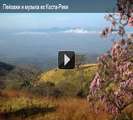San Jose Nights - Costa Rica
A weekly TV show bringing you the art and community of San Jose. This is a pilot episode.
Directed by Juan Serna
Starring
Glenda Gomez.
Directed by Juan Serna
Starring
Glenda Gomez.
Costa Rica was the point where the Mesoamerican and South American native cultures met. The northwest of the country, the Nicoya peninsula, was the southernmost point of Nahuatl cultural influence when the Spanish conquerors (conquistadores) came in the 16th century. The central and southern portions of the country had Chibcha influences. The Atlantic coast, meanwhile, was populated with African workers during the 17th and 18th centuries.
Costa Rican cuisine is a blend of Native American, Spanish, African and many other cuisine origins. Dishes such as the very traditional tamale and many others made of corn are the most representative of its indigenous inhabitants, and similar to other neighboring Mesoamerican countries. Spaniards brought many new ingredients to the country from other lands, especially spices and domestic animals. And later in the 19th century, the African flavor lent its presence with influence from other Caribbean mixed flavors. This is how Costa Rican cuisine today is very varied, with every new ethnic group who had recently become part of the country's population influencing the country's cuisine.
As a result of the immigration of Spaniards, their 16th-century Spanish culture and its evolution marked everyday life and culture until today, with Spanish language and the Catholic religion as primary influences.
The Department of Culture, Youth, and Sports is in charge of the promotion and coordination of cultural life. The work of the department is divided into Direction of Culture, Visual Arts, Scenic Arts, Music, Patrimony and the System of Libraries. Although the department creates many initiatives, they are constrained by lack of resources. Permanent programs, such as the National Symphony Orchestra of Costa Rica and the Youth Symphony Orchestra, are conjunctions of two areas of work: Culture and Youth.
Dance-oriented genres, such as soca, salsa, bachata, merengue, cumbia and Costa Rican swing are enjoyed increasingly by older rather than younger people. The guitar is popular, especially as an accompaniment to folk dances; however, the marimba was made the national instrument.
"Pura Vida" is the most recognizable phrase attached to Costa Ricans, and it reflects the Costa Rican way of life. Often, people walking down the streets, or buying food at shops say hello by saying "Pura Vida", which means pure life, or good life. It can be phrased as a question or as an acknowledgement of one's presence. A recommended response to "How are you?" would be "Pura Vida".
![]()





No comments:
Post a Comment